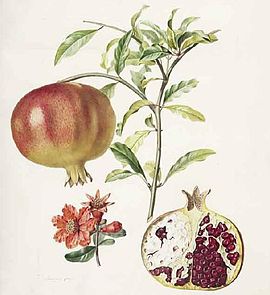Template:Species-2011-12-1
Species of the month[edit]
Pomegranate[edit]
Some facts on this tree:
Height: 5-8 meters.
Flowers: Bright red, 3 cm in diameter, with four to five petals.
Origin of name: "Pomegranate" is from the Latin "pomum granatum" which means "apple of Granada" (Granada, a city in southern Spain).
Range: Native to Persia and the western Himalayan range, spread to other parts of the world.
First mentioned: In the papyrus "Ebers" of Egypt, by Homer in the "Odyssey" and in the bible's "Book of Exodus".
First described: By the Swedish naturalist and "father of taxonomy" Linnaeus in 1753.
Punica granatum is tasty and beautiful; cultivated for its ornamental value as well as for the sweet fruit. It is categorized as a "super-fruit" because of its nutritional benefits. It contains many vitamins and minerals, has anti-antioxidant and anticancer proprties and helps in reducing blood pressure. In Jewish tradition, it is believed that each pomegranate fruit contains exactly 613 seeds, but the actual number can vary from 200 to about 1400. In the Northern Hemisphere the fruit season extends from September to February. This has earned it the nickname of "The Jewel of Winter". Around 760 cultivars of Pomegranate are known. They vary in fruit size, colour, hardness of seed, maturity, juice content and its acidity, sweetness, and astringency.
(Archived from Template:Species of the week)
